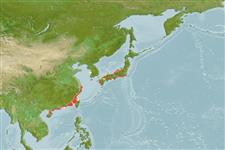Teleostei (teleosts) >
Blenniiformes (Blennies) >
Blenniidae (Combtooth blennies) > Blenniinae
Etymology: Laiphognathus: Greek, laiphos, -eos = rag, tatter + Greek, gnathos = jaw (Ref. 45335); longispinis: Name from Latin 'longus' for long and 'spina' for spine, refers to the sexually dimorphic elongation of some dorsal spines in males.
Environment: milieu / climate zone / depth range / distribution range
Ecology
Marine; demersal; depth range 5 - 30 m (Ref. 76746). Temperate
Distribution
Countries | FAO areas | Ecosystems | Occurrences | Point map | Introductions | Faunafri
Northwest Pacific: Japan, Taiwan, HongKong.
Size / Weight / Age
Maturity: Lm ? range ? - ? cm
Max length : 5.1 cm SL male/unsexed; (Ref. 76746)
Short description
Identification keys | Morphology | Morphometrics
Dorsal spines (total): 10 - 12; Dorsal soft rays (total): 20 - 23; Anal spines: 2; Anal soft rays: 21 - 24; Vertebrae: 38 - 40. This species is distinguished and compared from its congener L. multimaculatus by the following characters: in mature males, 3 to 5 of the 6th-10th dorsal spines elongated (vs. none); anterior and posterior nostrils with 3 and 2 cirri, respectively (vs. 2 or 3 on both nostrils); longest posterior nasal cirrus elongate, 68.4-166.7% of orbit diameter (vs. 18.8-100%); in mature males at least, the lower-lip flap is usually separated into anterior and posterior parts (vs. usually continuous); total dorsal-fin rays 31-34 (vs. 29-32); segmented anal-fin rays 21-24 (vs. 19-22); total vertebrae 38-40 (vs. 35-39); spots on cheek absent (vs. small spots present); usually large, dusky brown body spots forming diagonal bands anteriorly (vs. small spots scattered anteriorly); pectoral-fin base with distinct black spot both centrally and dorsally (vs. inconspicuous spots over entire fin base); belly with elongate black spot, from pelvic-fin base to before anus in mature males and females (wider in males) (vs. circular spot just before anus in males only); in males, abdomen becoming reddish (vs. abdomen not reddish); lips never reddish (becoming reddish at least in mature males) (Ref. 76746).
Adults are reported to occur on rocky slope area and small individuals are known to occur around sea urchins. Oviparous. Eggs are demersal and adhesive (Ref. 205), and are attached to the substrate via a filamentous, adhesive pad or pedestal (Ref. 94114). They lay eggs in a nest, using holes made by invertebrates on massive corals. The well-developed eggs are taken into the mouth and squeezed by the males and the newly hatched larvae swim out of its mouth. Larvae are planktonic, often found in shallow, coastal waters (Ref. 94114). Spawning season extends from the middle of May to the beginning of October in Kinko Bay, Japan (Ref. 76746).
Life cycle and mating behavior
Maturity | Reproduction | Spawning | Eggs | Fecundity | Larvae
Murase, A., 2007. A new species of the bleniid fish, Laiphognathus longispinis (Perciformes: Bleniidae), from southern Japan and Taiwan. Ichthyol. Res. 54:287-296. (Ref. 76746)
IUCN Red List Status (Ref. 130435: Version 2024-2)
Threat to humans
Harmless
Human uses
Tools
Special reports
Download XML
Internet sources
Estimates based on models
Preferred temperature (Ref.
123201): 19.2 - 26.9, mean 23.7 °C (based on 258 cells).
Phylogenetic diversity index (Ref.
82804): PD
50 = 0.7500 [Uniqueness, from 0.5 = low to 2.0 = high].
Bayesian length-weight: a=0.00575 (0.00253 - 0.01308), b=3.06 (2.86 - 3.26), in cm total length, based on LWR estimates for this (Sub)family-body shape (Ref.
93245).
Trophic level (Ref.
69278): 3.3 ±0.4 se; based on size and trophs of closest relatives
Resilience (Ref.
120179): High, minimum population doubling time less than 15 months (Preliminary K or Fecundity.).
Fishing Vulnerability (Ref.
59153): Low vulnerability (10 of 100).
